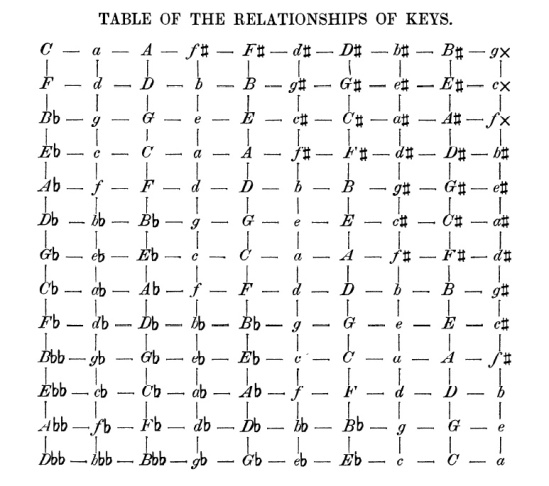Jacob Gottfried Weber (March 1, 1779 – September 21, 1839) was a German music theorist. One of the most useful tools he created was a chart of key relationships which I’m including here as an image.
The capital letters represent major keys and the lowercase letters represent minor keys. The chart shows us all the keys that are closely related to any one key. Using C as our example again, you can see that the major keys above and below are G and F. The minor keys on either side are cm and am. These are the 4 keys that are the most closely related to C. G and F share 4 chords each with C, am shares all chords (it’s the relative minor of C) and though cm shares no chords at all, it’s technically considered the same key because the note C is the tonal center of both keys.
Moving to the keys that are linked to the main key in question is always a smooth modulation. Writing one part of your song in C and another part in G sounds natural. If you want to move from one key to another that’s not as closely related, you can write a bridge between the two using the key or keys in between.
For instance, you could change from C to bm by moving through G and D to settle on bm… You could always just move directly to the next key too. It all depends in the end on what you want to hear in your music!!!
The chords in the 24 keys (12 major and 12 minor) are below. I list the relatives together because they share chords but they are technically different keys.
Since I don’t have a flat character on my keyboard, I use a lowercase b… Which is only really confusing when I need a b flat minor chord, which I write as bbm… Sorry!
C/am – C, dm, em, F, G, am, bdim
G/em – G, am, bm, C, D, em, f#dim
D/bm – D, em, f#m, G, A, bm, c#dim
A/f#m – A, bm, c#m, D, E, f#m, g#dim
E/c#m – E, f#m, g#m, A, B, c#m, d#dim
B/g#m – B, c#m, d#m, E, F#, g#m, a#dim
F#/d#m – F#, g#m, a#m, B, C#, d#m, e#dim (also known as Gb/ebm)
C#/a#m – C#, d#m, e#m, F#, G#, a#m, b#dim (also known as Db/bbm)
Ab/fm – Ab, bbm, cm, Db, Eb, fm, gdim
Eb/cm – Eb, fm, gm, Ab, Bb, cm, ddim
Bb/gm – Bb, cm, dm, Eb, F, gm, adim
and finally…
F/dm – F, gm, am, Bb, C, dm, edim
Now experiment!

